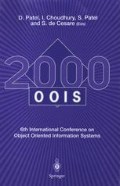Abstract
In this paper we present an approach to allow monitoring of XML documents on the World Wide Web. We describe a distributed information monitoring architecture based on monitor rules. The architecture preserves the autonomy of the participating documents and allows evolution of the system by adding, removing and modifying XML documents. In order to illustrate the approach we present an example in the financial domain.
Access this chapter
Tax calculation will be finalised at checkout
Purchases are for personal use only
Preview
Unable to display preview. Download preview PDF.
References
S. Adler, A. Berlund, J. Caruso, S. Deach, A. Milowski, S. Parnell, J. Richman, and S. Zilles. Extensible Stylesheet Language (XSL) Version 1.0. Working Draft http://www.w3.org/TR/2000AVD-xsl-20000112, World Wide Web Consortium.
Apache XML project. Cocoon, http://xml.apache.org/cocoon/.
BIOpolymer Markup Language. http://www.bioml.com/BIOML/index.html.
T. Bray, J. Paoli, and CM. Sperberg-McQueen. Extensible Markup Language. Recommendation http://www.w3.org/TR/1998/REC-xml-19980210, World Wide Web Consortium.
J. Clark. XSL Transformations (XSLT) Version 1.0. Recommendation http://www.w3.org/TR/1999/REC-xslt-19991116, World Wide Web Consortium.
J. Clark and S. DeRose. XML Path Language (XPath). Recommendation http://www.w3.org/TR/1999/REC-xpath-19991116, World Wide Web Consortium.
S. Cluet, C. Delobel, J. Simeon, and K. Smaga. Your Mediators Need Data Conversion! In Proceedings of ACM-SIGMOD International Conference on Management of Data, 177–188, 1998.
Chemical Markup Language, http://www.xml-cml.org.
H. Deitel, P. Deitel, and T.R. Nito. Internet and the World Wide Web — How to Program. Prentice Hall, ISBN 0-13-016143-8, 1999.
S. DeRose, E. Maler, D. Orchard, and B. Trafford. XML Linking Language (Xlink) Version 1.0. Candidate Recommendation http://www.w3.org/TR/2000/CR-xlink-20000703, World Wide Web Consortium.
A. Deutsch, M. Fernandez, D. Florescu, A. Levy, and D. Suciu. A Query Language for XML. In International World Wide Web Conference, 1999. http://www.research.att.com/~mff/files/final.html.
S. Dongwook. Structured Querying, Indexing, and Retrieval for SGML/XML Documents. In Proceedings of SGML/XML Japan’ 98, pp. 199–214.
B. DuCharme, XML: The Annotated Specification. Prentice Hall PTR, ISBN: 0-13-082676-6, 1999.
E. Ellmer, W. Emmerich, A. Finkelstein, D. Smolko, and A. Zisman. Consistency Management of Distributed Documents using XML and Related Technologies (submitted for publication).
Fatdog Software, XML Query Engine, http://www.fatdog.com/.
A Markup Language for the FIX Application Message Layer. http://www.oasis-open.org/cover/fixml.html.
Financial Product Markup Language, http://www.fpml.org/.
R. Goldman, J. McHugh, and J. Widom. From Semistructured Data to XML: Migrating the Lore Data Model and Query Language. Proceedings of the 2nd International Workshop on the Web and Databases (WebDB’99), Philadelphia, Pennsylvania, June 1999.
GoXML, http://www.goxml.com/.
The XML Similarity Engine, http://www.infoglide.com/technology/techprod.htm.
Ultaseek Server v3.1 Release Notes. http://software.infoseek.com/products/ultraseek/docs/relnotes_3_1.htm.
Mathematical Markup Language. http://www.w3c.org/Math/.
J. McHugh and J. Widom. Query Optimization for XML. Proceedings of the Twenty-Fifth International Conference on Very Large Data Bases, Edinburgh, Scotland, September 1999.
Network Trade Model. Trade Definitions User Guide, http://www.infinity.com.
The XML Cover Pages, http://www.oasis-open.org/cover/sgml-xml.html.
XML Query Requirements, W3C Working Draft 31 January 2000. http://www.w3.org/TR/2000/WD-xmlquery-req-20000131, World Wide Web Consortium.
A Zisman, W. Emmerich, and A. Finkelstein. Using XML to Build Consistency Rules for Distributed Specifications. 10th International Workshop on Software Specification and Design (IWSSD), San Diego, November, 2000.
Author information
Authors and Affiliations
Editor information
Editors and Affiliations
Rights and permissions
Copyright information
© 2001 Springer-Verlag London Limited
About this paper
Cite this paper
Spanoudakis, G., Zisman, A. (2001). Information Monitors: An Architecture Based on XML. In: Patel, D., Choudhury, I., Patel, S., de Cesare, S. (eds) OOIS 2000. Springer, London. https://doi.org/10.1007/978-1-4471-0299-1_38
Download citation
DOI: https://doi.org/10.1007/978-1-4471-0299-1_38
Publisher Name: Springer, London
Print ISBN: 978-1-85233-420-8
Online ISBN: 978-1-4471-0299-1
eBook Packages: Springer Book Archive

